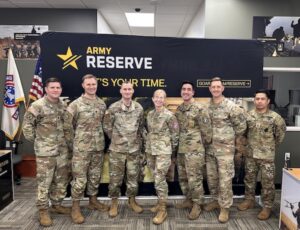Joint Base San Antonio, Texas (March 26, 2024) – The Department of Defense has faced several challenges that have led to lower recruiting numbers, and prevented the Army, Air Force and Navy from reaching FY 2023 recruiting goals.
One of those challenges was the implementation of the DoDs new medical records platform in 2022, MHS Genesis. Prior to MHS Genesis, applicants could omit or forget to include medical history that would prevent them from entering military service.
The new MHS Genesis system consolidates applicants’ medical history from different databases and flags all medical issues, which created a bottleneck at Military Entrance Processing Stations (MEPS).
Brig. Gen. Katherine Simonson, deputy commanding general medical, U.S. Army Recruiting Command (USAREC) and task force commander for the MPAT said, “With the deployment of MHS Genesis, an applicant’s entire medical history became available to the medical review process. This availability of medical information has added time and workload when prescreening applicants, gathering documents, and completing consults to support waivers to clear medical disqualifying conditions. Although MHS Genesis has increased the medical timeline for accessions into the Army for those with possible disqualifications, the percentage of disqualified candidates did not increase significantly for 2022 to 2023.”
“Because it is a better tool to review an applicant’s medical history and better ensure they meet the qualifications for military service, it is taking more manpower and resources to accomplish. We need to employ automation and the digital processing as the next steps forward to solving the medical processing challenge,” said Simonson.
The increase in MHS Genesis workload for recruiters and USMEPCOM staff did not align with an increase in manpower; therefore, thousands of Army applicants were overdue for prescreens and medical review.
In discussing the pipeline for USMEPCOM processing Simonson stated that, “recruiting numbers decreased on an alarming scale during COVID, but the implementation of MHS Genesis during a staffing shortage compounded the problem.”
The increased workload for the MEPS providers with the access to Health Information Exchange (HIE) data exposed staffing deficiencies which impacted USMEPCOMS ability to conduct timely records reviews and exams.
“It was the perfect storm of a crisis that pinpointed the medical processing part of onboarding applicants into the services,” Simonson added.
Former Army Surgeon General, Lt. Gen. R. Scott Dingle, established the Medical Processing Augmentation Team (MPAT) to streamline the medical processing pipeline. The MPAT coordinated a surge of military medical providers to various MEPS sites around the country to help process applicants and reduce overdue prescreens.
The providers are from military treatment facilities, operational forces and training programs in MEDCOM, FORSCOM, and TRADOC.
In addition to the military providers, 68 new nurse practitioner and physician assistant positions were established under an urgent hire authority to augment medical staff at 65 MEPS sites across the country. Several of those positions were designated as traveling positions to have flexibility to assist MEPS sites that have applicant increases.
Prior to the surge of providers, the prescreen time to review applicant records was an average of 4.3 days and has now been reduced to an average of 1.1 days.
“In one month, the surge providers at the sites have cleared all overdue prescreens. That enables the applicants to get right on the floor,” said Simonson.
The MPAT team is analyzing other processes and systems that can be improved to streamline the medical screening pipeline for applicants.
“We need to increase the interoperability of our data systems between the services and U.S. Military Entrance Processing Command, so we can improve our policy and processes. That’s going to help us get the applicants through the pipeline more smoothly,” said Simonson.
Simonson said she is focused on the holistic journey of applicants to ensure they have a positive experience during the entire process from contact to contract.
“Every partner on this team is working together to serve the applicants who are just trying to fulfill their dreams to serve their country,” she said. “It’s inspiring to me to hear their call to purpose, so I want to do what I can to take their frustration away from this process.”
“The Army is taking innovative, aggressive steps to reverse our recruiting shortfalls. We are seeing signs of early progress and we look forward to continuing this course,” said Simonson.
